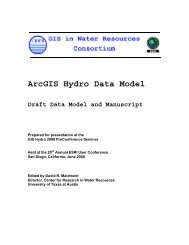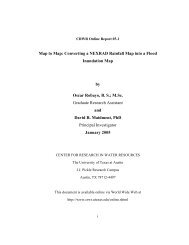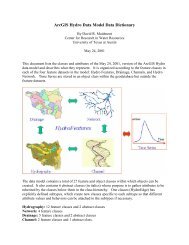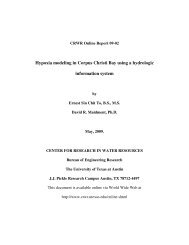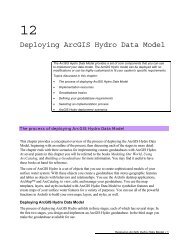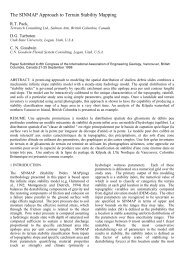View the Whole Report - Center for Research in Water Resources ...
View the Whole Report - Center for Research in Water Resources ...
View the Whole Report - Center for Research in Water Resources ...
Create successful ePaper yourself
Turn your PDF publications into a flip-book with our unique Google optimized e-Paper software.
Sample Descriptions<br />
Samples T1-T30<br />
Prelim<strong>in</strong>ary samples T1-T30 were collected <strong>in</strong> paired sets to assess <strong>in</strong>stantaneous<br />
filtration efficiency <strong>for</strong> a specific study application. The <strong>in</strong>dividual upstream samples <strong>for</strong><br />
<strong>the</strong> set T1-T12 were collected near <strong>the</strong> fabric at mid-range depths of reta<strong>in</strong>ed flows. For<br />
site 1, m<strong>in</strong>or downstream flow concentrations facilitated <strong>in</strong>-stream sample collections<br />
(see Figure A3 <strong>in</strong> Appendix A). For Sites 2 and 3, <strong>the</strong> downstream sample was carefully<br />
collected from <strong>the</strong> surface flow of <strong>the</strong> fabric adjacent to <strong>the</strong> upstream sample location (see<br />
Figures A4 and A5 <strong>in</strong> Appendix A). Sample T13 was collected after long term retention<br />
of an upstream pool to evaluate <strong>the</strong> effects of <strong>in</strong>creased hold<strong>in</strong>g times.<br />
Samples T15-T24 (see Figure A6 <strong>in</strong> Appendix A) and T25-T30 (see Figure A7 <strong>in</strong><br />
Appendix A) of Site 1 were collected accord<strong>in</strong>g to <strong>the</strong> orig<strong>in</strong>al methodology. In <strong>the</strong>se<br />
<strong>in</strong>stances, <strong>the</strong> downstream flow concentration was m<strong>in</strong>imal and <strong>the</strong> majority of<br />
downstream samples were collected at <strong>the</strong> face of <strong>the</strong> fabric.<br />
Samples T31-T48<br />
Samples T31-T48 were collected as multiple, <strong>in</strong>dividual, non-paired samples at<br />
various upstream and downstream locations <strong>in</strong> order to explore possible particle load<strong>in</strong>g<br />
distributions. Samples T31-T42 of Site 4 (see Figure A8 <strong>in</strong> Appendix A) were collected<br />
at various locations with<strong>in</strong> <strong>the</strong> upstream pond and various downstream locations along<br />
<strong>the</strong> <strong>in</strong>ternal walls of an uncovered <strong>in</strong>let. Dur<strong>in</strong>g this collection opportunity at Site 4, <strong>the</strong><br />
upstream retention was sheet-like <strong>in</strong> nature and pond<strong>in</strong>g depths were m<strong>in</strong>imal. Samples<br />
T43-T48 (see Figure A9 <strong>in</strong> Appendix A) were ga<strong>the</strong>red <strong>in</strong> a similar fashion at site 1.<br />
Although multiple location sampl<strong>in</strong>g was not appropriate <strong>for</strong> <strong>the</strong> small downstream flow<br />
channel, three samples were taken at a s<strong>in</strong>gle location to exam<strong>in</strong>e consistency. Individual<br />
samples were collected throughout <strong>the</strong> upstream pond.<br />
63




